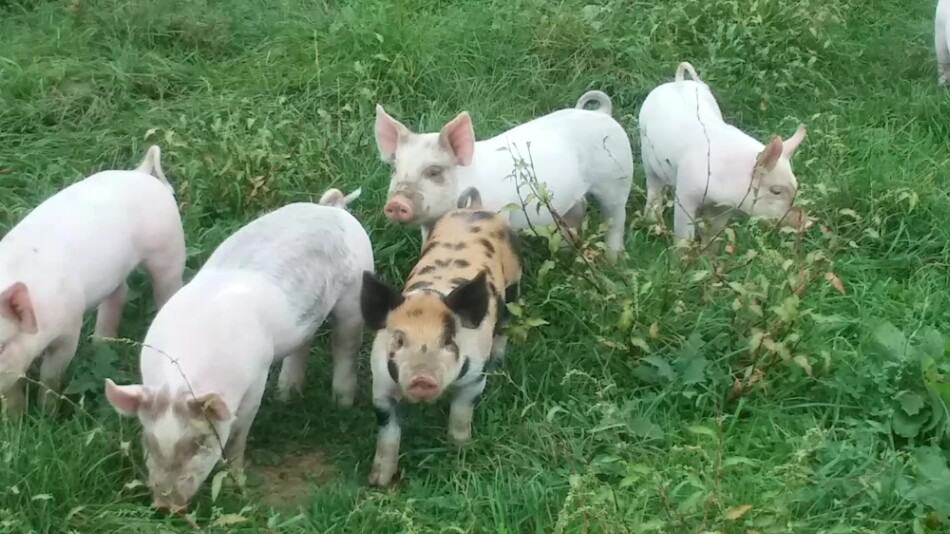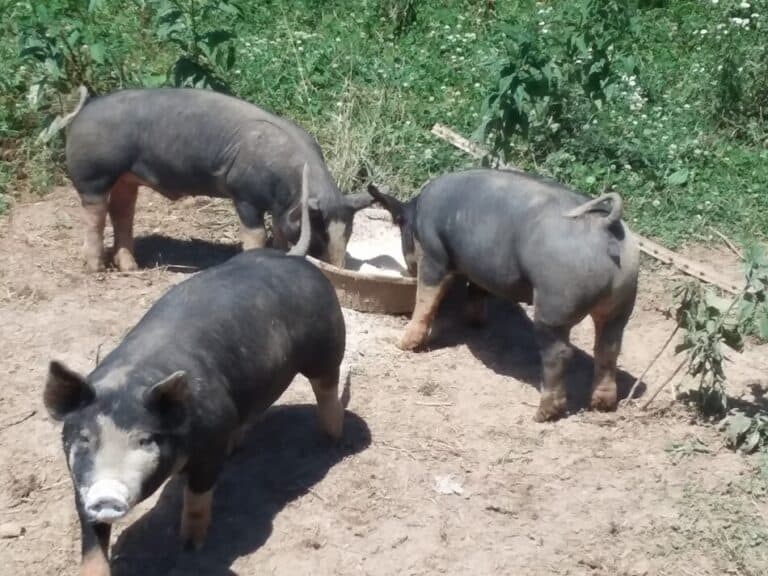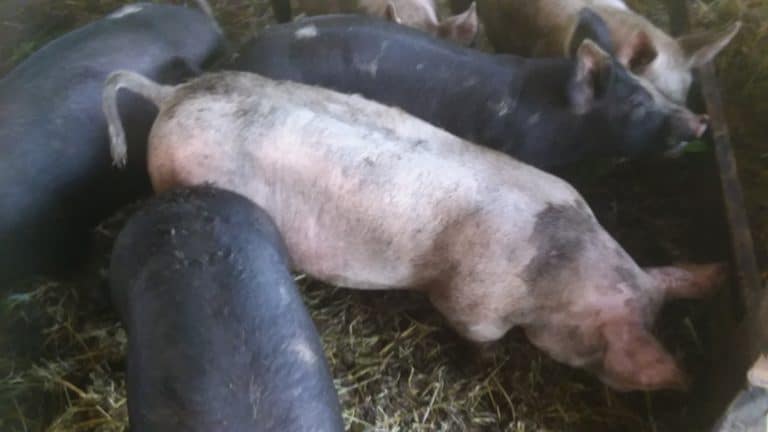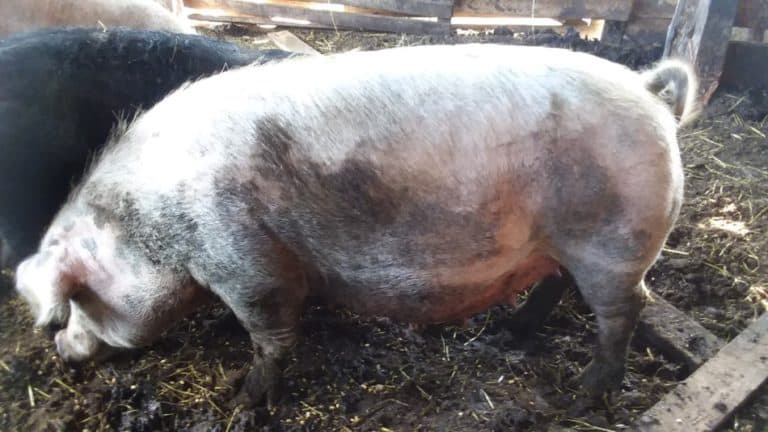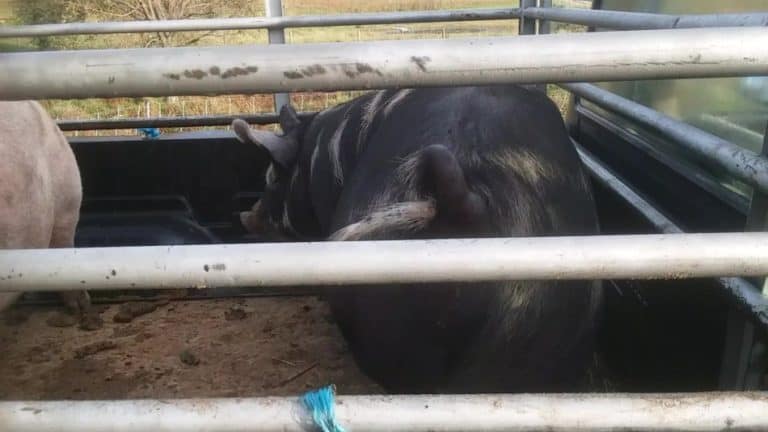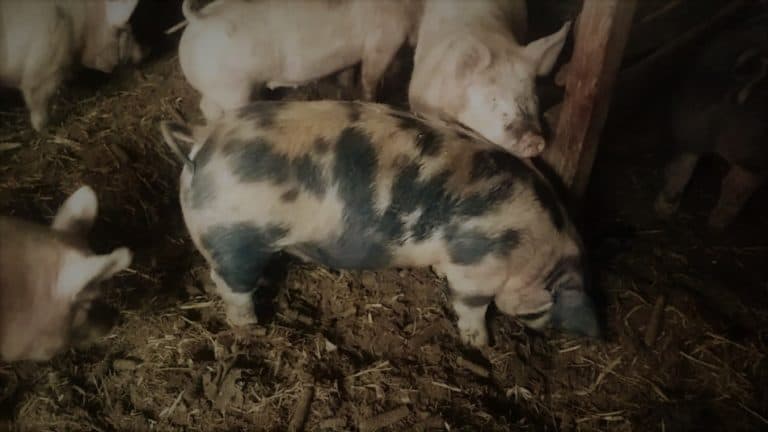How Many Pigs On 5 Acres? (With Pasture Rotation Plan)

The popularity of home raised pastured pork is on the rise and it’s no wonder, pigs are quick to raise and amazing to eat!
To get started raising some pastured pigs, you need to know the basics, like how many pigs can you have on your acreage.
If the pigs are rotated through the pasture, you can keep 50 finishing/market size pigs on 5 acres, which is 10 pigs per acre, in a good forage production area. If you are not rotating the pigs, you can keep 15-20 finishing pigs on 5 acres, which is 3-4 per acre.
| Type of pig | Pigs per acre | Pigs on 5 acres |
| Feeder pigs, 50-100 pounds each | 15-30 | 75-150 |
| Finishing/Market hogs, 100-200+ pounds each (rotated pastures) | 10-20 | 50-100 |
| Finishing/Market hogs, set stocked pasture (no rotation) | 3-4 | 15-20 |
| Sows with litters | 6-8 | 30-40 |
| Gestating sows | 8-12 | 40-60 |
The size and type (sow, market hog, feeder pig) of pigs you have combined with the forage production capabilities of your land will determine how many pigs you can have per acre or for five acres.
In the chart above, use the lower numbers for areas with poor pasture production and the higher numbers for areas with good forage growth in the pastures.
Also, consider the soil in the area you plan to pasture the pigs.
Wetter ground will show more pig impact than ground that does not sit wet and sandy soils will drain better, showing less pig impact, than the more clay type soils.
How Many Pounds Of Feed Do Pigs Need? will give you a good estimate of the amount of feed you should plan on buying, if you’d like to know ahead of time.
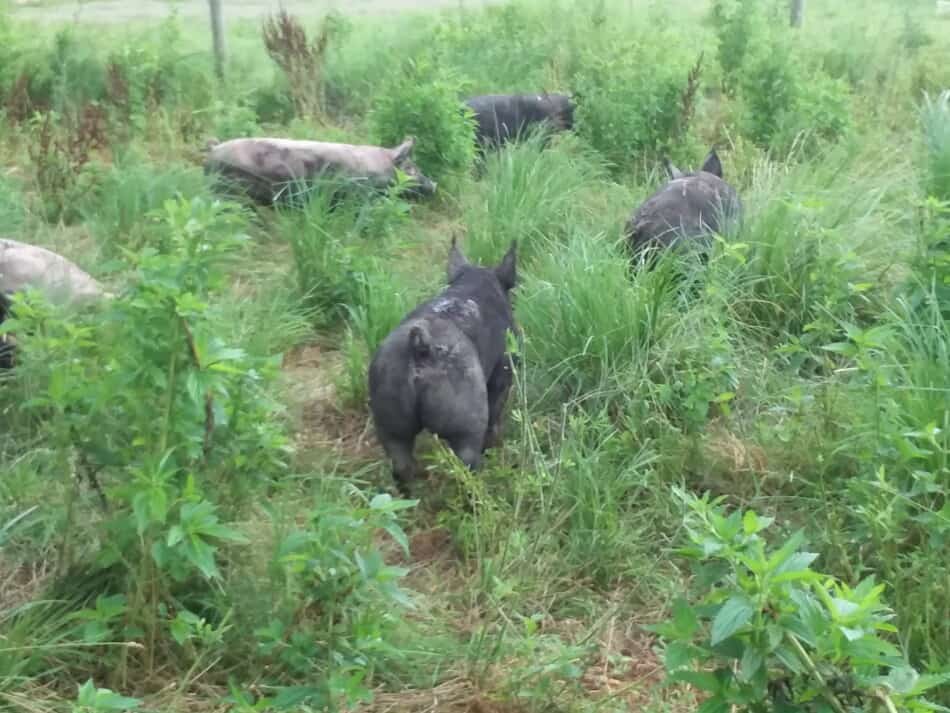
10 market hogs can be raised per acre of pasture
10 market or finisher sized pigs can be raised per acre of pasture.
While this is a conservative number, it’s better to start a bit under stocked, since you are new, than to have too many pigs for your level of management abilities.
If you have great pastures, meaning lots of forage out there and soil that can handle more pig pressure, you can go up to 20 pigs per acre.
Is Your Pig Ready To Butcher? shows you ways to tell if your pig is fully finished (well marbled) so you’ll get the wonderful flavor you are hoping for in your pork!
Start with fewer pigs per acre the first year
If you are just starting out, plan on the lower end of 10 pigs per acre. This way you’ll have a bit of wiggle room on your management.
The more pigs you have in a small area, the more on point your management has to be.
By using the lower number of 10 pigs, you build some grace into the system, which you’ll likely need since you are new to pigs.
Once you’ve got pastured pigs figured out for your area, raise the number of pigs to suit your farm. You might be able to go up to 20 finishing pigs per acre or your farm may be more suited to 15.
Experience is the best teacher here. Raise a few pigs, see how it goes and decide what adjustments you plan to make for the next batch.
4 market hogs can be raised per acre of woods
Start with 4 pigs per acre of woods. If you have a lot of understory growth, you may able to go up to 6 pigs per wooded acre.
Forested or woodland pork is a cool idea that is becoming more popular, one we have not tried since we are the vast majority pasture, but I do see and read a lot about it.
I’m always interested in how folks are raising their pigs. Pigs love the woods, I’m sure, but the real question is do the woods love the pigs? I’d not thought of this before I came across this article.
If I had pigs in my wooded area, I would want to know how are the pigs impacting the trees and are you seeing all of the impact immediately or are there down the road consequences that are delayed.
Read Pigs ‘n Trees from Cornell Small Farms Program for more details.
Once again, we don’t have pigs in the woods so I can’t speak from experience. I can only say this is information I would want to have to make an informed decision.
Since I would want to know, I figure you would, too.
6 sows with piglets can be raised per acre of good pasture
If you are talking about breeding stock pigs, you can raise 6-8 sows with their litters per acre of good pasture.
For gestating sows, the number per acre is higher, more like 8-12.
Sows can get a substantial amount of their diet from pasture and are actually one of the best type pigs to have on pasture, since they can use more of it.

Rotate your pig pasture
All of these numbers of pigs per acre require that you are rotating the pigs through smaller sections of the pasture, not giving them the entire area at once.
Rotating pastures means that the pigs only have access to a certain part of the pasture for a certain time, then they are moved to a new section and the grazed section is left to regrow.
The regrowing phase is what makes this whole system work. This is the hardest part to understand, as a beginner.
It’s not how long you keep the pigs on the pasture (as long as you are not allowing total destruction), it’s how long you keep them off of the pasture that matters the most.
The pastured area must rest, pig free, to regrow well.
Getting the pigs off of a particular section of pasture and letting it regrow gets you more total forage production for each acre.
Rotation also prevents the pigs from turning one particular favorite spot into a muddy mess.
If you are not planning on rotating your pasture, you’ll need to lower the stocking rate, amount of pigs you have per acre, substantially.
You should also expect more damage to the pasture from rooting and forming wallows, since the pigs are being kept in one area the whole time.
Rotate your pig pasture every 10-14 days
Plan to rotate your pig’s pasture every 10-14 days. As the pigs get bigger, you’ll need to rotate more quickly than when they were smaller, just because they are eating and rooting more as get they grow.
As you go, you’ll learn how fast you need to rotate the pigs for your area and pasture conditions. Start with the plan of 10-14 days and work from there.
If you want to, you can rotate more frequently than this, but do not rotate less frequently.
Staying in one area increases damage to the area from compaction and rooting and will increase the likelihood of parasites being ingested.
Polyface Farm uses as simple rotation plan, when the feeder is empty you move the group.
This automatically makes smaller pigs stay longer and larger pigs, that eat the same amount of feed more quickly, also rotate more quickly.
I worked out the math, they have 35-50 pigs getting 4,000 pounds of feed per move which equals 80-112 pound of feed per pig per move. The moves are .5 acres each, which is 622-436 sq. ft. per pig per move.
You’ll have to work out the numbers that fit your area, using the Polyface numbers will give you a good place to start your planning.
Pig pasture rotation plans should fit your situation
Set up your pasture rotation based on what equipment you have, access to the pig’s pasture and how you choose to manage the pastured area.
Here are two easy to see rotation plans, both of which will work fine for you and your pigs.
These are two generic rotation plans, to give you an idea of how to set up your pig’s pasture rotation plan to best suit your situation.
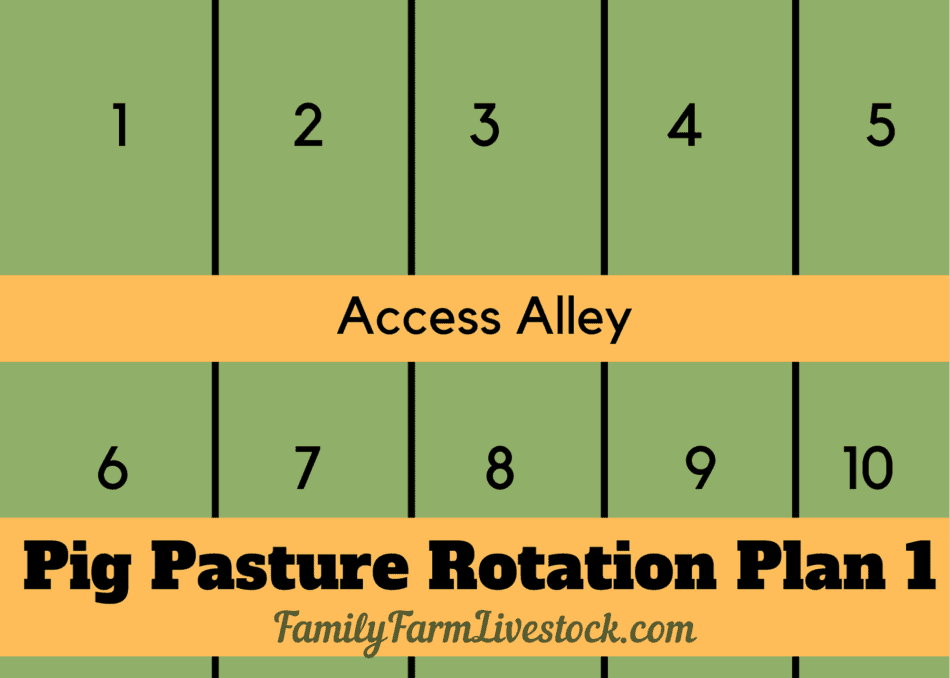
You can completely rotate pigs (waterer, feeder, shelter) each time
The first option is the move everything rotation. This means the pigs get a completely new section of pasture with each rotation, meaning the feeder and waterer move to the new spot, as well.
This is the method that Polyface uses. Note the access alleyway. This alleyway is so you can get the equipment moved and tend to the pigs as needed, meaning refill the feeders.
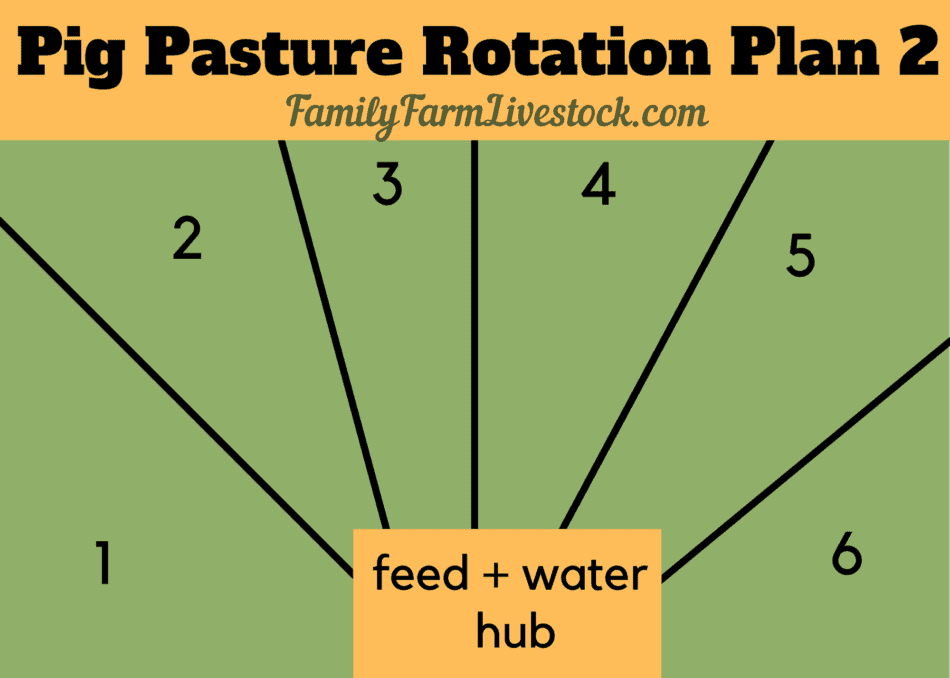
You can use a hub/base camp pastured pig rotation plan
A hub or base camp rotation plan may be best for your pig’s pastured area.
This plan is for folks that want to set up one area for the feeder, waterer and shelter for the pigs and change the section of pasture that the pigs have access to.
This plan could work better for farms that have oddly shaped fields or places that they want the pigs, yet can not get the support equipment (tractor, truck) out there.
With the base camp plan, you only need to set up the main area one time and let the pigs walk themselves to the hard to reach areas.
With the base camp pasture set up, the pigs will damage the home area, simply because they never are kept off of it. If you don’t want this damage, use a complete rotation, as described above.
All pastured pig rotation plans need to have water, feed, fence and shelter
No matter which pig rotation plan you choose, you’ll need to have water, feed and shelter available to your pigs free choice. The shelter is for shade and could be in the form of trees, shrubs or a portable shelter you move with your pigs.
You’ll also need to have some sort of fencing planned, so you can keep the pigs off of areas they have already eaten down.
This saves the pasture from turning into a muddy mess and keeps down the parasites.
Most folks would be using electric fencing, either single strand wire or polybraid or hog netting. Non electric fences are subject to damage by the pigs.
Pastured pigs need supplemental feed to grow quickly
There is a lot of confusion regarding pastured pigs and feed. Let me be clear, most pastured pigs need supplemental feed to grow well!
Especially if you are a beginner, it’s just easier to manage your pigs well if you feed some grain!
Also, if you bought your pigs from a farm that normally feeds grain (this would be true for the vast majority of pigs in the U.S.) your pigs are selected to grow well on grain and need those calories to grow at the rate you are expecting.
Check out Sugar Mountain Farm a Vermont pig farm feeding no grain and using their own lines of pasture based genetics, if you want an idea on raising pigs without grain.
The supplemental feed can be something locally available to you that is not ground pig feed, like cheese trimmings, whey, pumpkins, sunflowers, extra or damaged produce, etc.
These are all higher calorie foods help the balance out your pig’s daily ration to make up for the lack of energy in grass.
A pig’s digestive system needs higher calorie foods to provide enough energy for growth. The smaller the pigs are, the less of their total diet can come from forages.
This means that bigger/older pigs get more use out of pasture or other forages than younger pigs do.
A pasture based system takes advantage of the sow’s excellent grazing ability. Hogs are
GrassWorks.org, Small Scale Pastured Hog Production
versatile omnivores and will forage on legumes, grasses and non-legume brassicas (as
well as flowers, fruits, weeds, seeds, acorns, worms and insects). By most estimates,
pasture can replace up to 50% of the diet in gestating sows and 30% of a finishing diet.
Generally speaking, sows can get 50% of their needs from forages, since they are fully grown and have a mature digestive system.
Most finishing pigs can get 30% of their needs from forages. This is a significant percentage of calories, but still requires 70% of the diet to be high energy feeds.
The 70% high energy feeds do not have to be grain, but it has to be something other than grass for these pigs. To be clear, these numbers (30% of feed from forages for finishing pigs) are for daily feed intake.
As mentioned above, Sugar Mountain has the genetics to raise pigs without grain or supplements, but if you don’t have these genetics, your pigs need some supplemental calories to grow well on pasture.
Overall, pastured pigs take more feed to raise up to marketing size, since they burn more energy outside, running around. 15% more feed, in total, according to PROOF (Pasture Raised On Open Fields).
Free range pigs have a much higher requirement for DE energy and could eat up to 15% more feed than pigs in pens kept indoors and not allowed to exercise.
proof.net.au, Feeding Free Range Pigs
If you keep pigs in the summer only, you can have more per acre
If you are planning on keeping pigs in the summer only, so you are buying feeder pigs and finishing them out then going pig free for the non grazing season, you can have more pigs per acre than someone keeping pigs year round.
Here’s why: let’s say you get 10 piglets that are 60 pounds each in May and raise them to finishing size by mid September.
Since you are raising pigs only during the productive part of the growing season, your pasture can handle more pigs per acre because there is more forage available for them to eat.
If you live in an area with good pasture growth, summer only pigs would need half of the acreage of year round or extended season pigs, simply because the grass is allowed to grow rather than being eaten early on by the pigs.
Grass growth is exponential, meaning growth in the first few days after cutting, or it being eaten, is very little compared to it’s growth in a few weeks after it was cut or eaten.
There is just more grass out there for your pigs!
This schedule would have your land resting from mid September through May, giving you some late and early season growth, while the unoccupied pastures are regrowing during the time you have these pigs.
The non pig time is when the pastures rebuild themselves and when parasites are left to die in the field rather than living in your pigs. Both of which increase the productive ability of your land.
Consider using half (or less) of your land for pigs
I know the point of this article is how many pigs you can keep on 5 acres, but consider using less of your land, for multiple reasons.
Since you are new to pigs on pasture, it may be best to use a smaller section of your total land for your pastured pig adventure.
This way, you have extra area to expand to, if your initial estimates are off and you can raise something else on the remaining land.
You can always go bigger or relocate the pigs, if you have more land to go to or even if the weather does not cooperate and you have to change your management mid summer.
The secret to rotating animals on pasture, whatever the animal is, is to watch the pasture and adjust your plan, as needed.
You may need to change your pig pasture area or rotation plan
Did you pick a nice lush, valley for your pigs and now it’s raining like crazy so the pigs need moved before they float away?
What if you picked a spot you were sure you could get feed to, but now it turns out to be way more hassle than you thought and you need to change your plan.
These are normal things that happen every year to anyone raising animals on pasture. Learning to adjust is the art of animal husbandry, which you’ll learn from experience.
When you have another area to put your pigs, you can adjust to whatever craziness the weather or the pigs throw at you.
Resources:
Sugar Mountain Farms article How Much Land per Pig? gives numbers of pigs per acre and weights of those pigs
GrassWorks Grazing Guide by Brigid O’Meara, chart with number of pigs per grazing acre based on type of pigs and weight
Cornell Small Farms Program Pigs ‘n Trees, an article discussing the potential damage of pigs being kept in wooded areas
